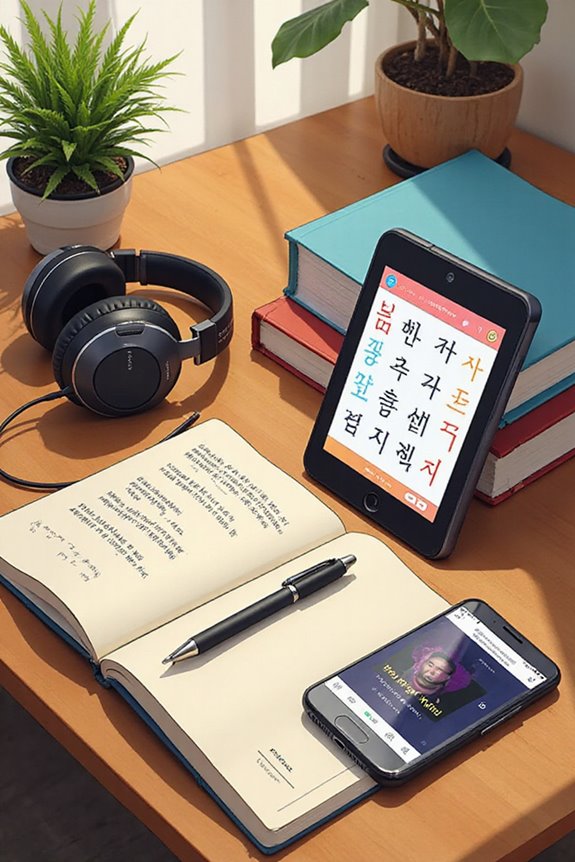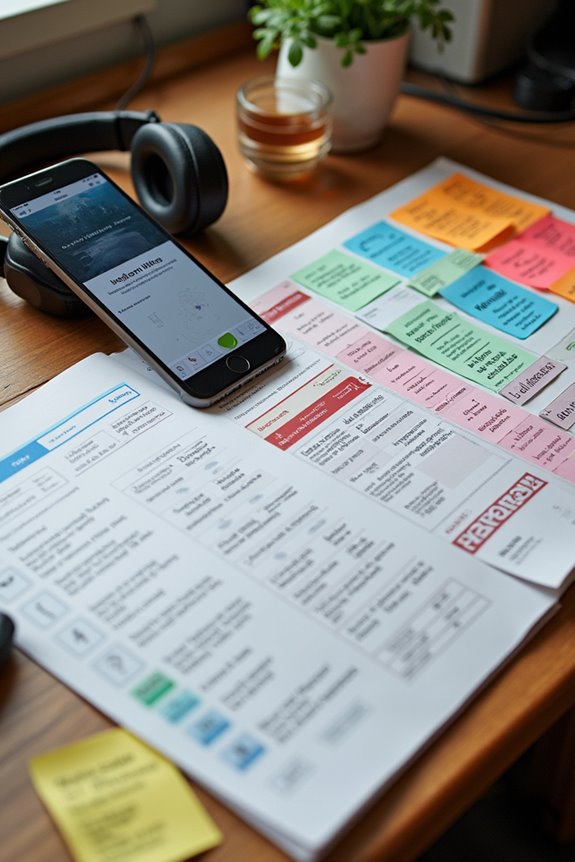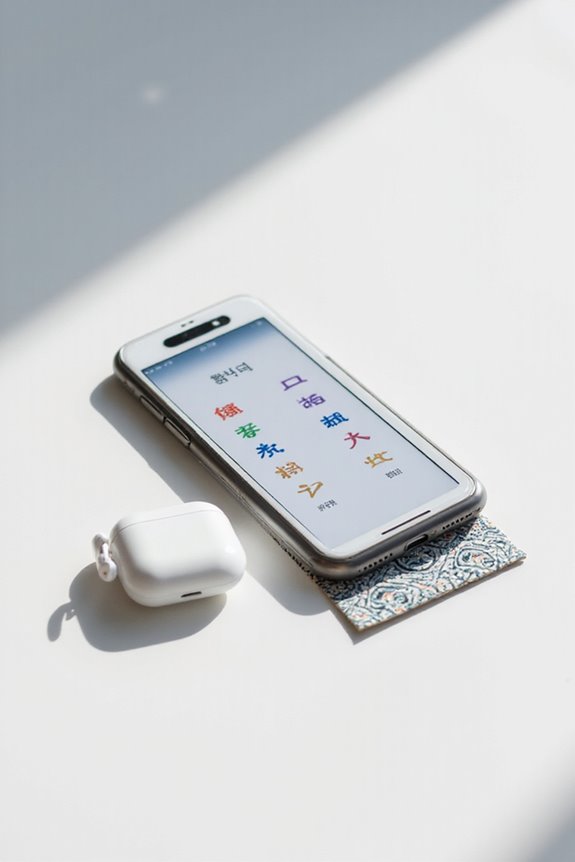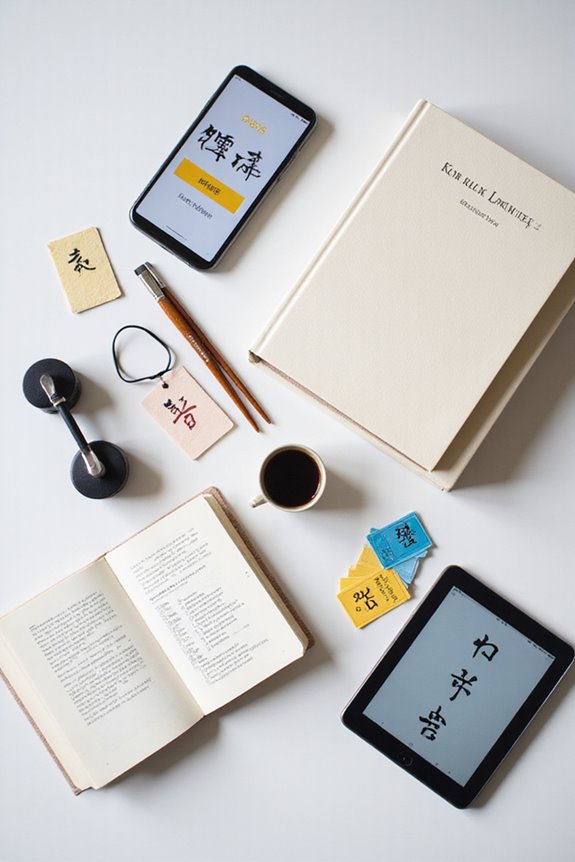When considering the best Korean language learning videos, we recommend channels like “Talk To Me In Korean,” which provides structured lessons suitable for beginners, and “Korean With Miss Vicky,” focusing on practical, conversational skills. For K-Pop enthusiasts, “Jaeguchi” integrates cultural content effectively. Additionally, “GO Billy Korean” offers humor and relatability, enhancing engagement across proficiency levels. These resources cater to diverse learners by incorporating various methodologies, interactive features, and cultural insights, which are essential for language acquisition. Further insights will enhance your understanding of effective options.
Key Takeaways
- “Talk To Me In Korean” offers structured lessons ideal for beginners looking to master the basics effectively.
- “Korean With Miss Vicky” emphasizes practical expressions, making it great for learners focused on conversation skills.
- “GO Billy Korean” uses humor and relatable content, appealing to a wide range of proficiency levels.
- “Jaeguchi” integrates K-Pop, providing a fun and culturally engaging way to learn Korean for music enthusiasts.
- “Korean Unnie” focuses on interactive learning experiences, perfect for those who enjoy a hands-on approach.
Overview of Popular Korean Language Channels
As we explore the domain of Korean language learning channels, it’s evident that various platforms cater to diverse learning styles and objectives. For instance, “Talk To Me In Korean” excels with its structured lessons and clear explanations, appealing to learners who prefer a methodical approach. In contrast, “Korean With Miss Vicky” intrigues those looking for practical expressions and conversational skills through engaging content. “Jaeguchi” captures K-Pop enthusiasts by introducing language learning through music, meeting the interests of culturally-driven learners. Additionally, “GO Billy Korean” offers a humorous and relatable approach for all proficiency levels, while “Korean Unnie” emphasizes interactive, fun learning experiences. These channel comparisons highlight how learner preferences play a significant role in selecting the right resources.
Teaching Methodologies and Styles

Various teaching methodologies and styles emerge within the domain of Korean language learning, each tailored to meet the diverse needs of learners. One effective approach is experiential learning, which emphasizes meaningful interactions with the language. For instance, dynamic immersion techniques utilize images paired with Korean words, fostering contextual understanding without reliance on translation. Additionally, interactive techniques, such as conversation drills and podcast-style dialogues, enhance learners’ confidence and comprehension. This combination of methods allows for practical vocabulary and grammar acquisition, enhancing real-life conversational skills. By integrating short videos, themed content, and native speaker engagement, learners benefit from a rich, varied format that keeps them engaged and focused on daily language applications, ensuring steady progression.
Content Focus for Different Learners

Understanding the content focus for different learners in Korean language education helps us cater to their unique needs and enhance their learning experience. For beginners, strategies often include mastering the alphabet, basic grammar, and essential vocabulary through channels like TTMIK and Korean Squirrel. Intermediate challenges may involve vocabulary expansion, pronunciation practice, and cultural insights, which enhance comprehension and speaking abilities. Advanced techniques focus on mastering complex grammar, idiomatic expressions, and engaging in debates to develop fluency. Additionally, immersion benefits can be gained through K-Pop and daily vlogs that provide cultural context. By recognizing these varied content focuses, we can better select videos that align with each learner’s proficiency level and goals, ensuring a more effective learning journey. Moreover, leveraging robust audio resources can significantly improve pronunciation skills and overall language acquisition.
Engaging Features for Language Acquisition

To effectively foster language acquisition, incorporating engaging features into learning environments is essential. Interactive quizzes, for instance, allow learners to test their knowledge and receive immediate feedback, enhancing retention. We can also employ gamification strategies, such as rewards and leaderboards, to create a competitive, enjoyable atmosphere that keeps students motivated. Additionally, using real-life scenarios in videos makes the language more practical, enabling learners to connect with the material effectively. Collaborative tools, like group chats or discussion boards, encourage interaction and a sense of community among learners. By integrating these features, we not only increase student engagement but also support more meaningful language development, ensuring the learning experience is both effective and enjoyable for everyone involved.
Suitability for Various Skill Levels

Many language learners encounter challenges when selecting resources suitable for their skill levels, making it essential for educators and learners alike to identify videos that meet specific needs. For beginners, channels like Beeline Language and 90 Day Korean provide engaging beginner resources that simplify foundational concepts through short, structured lessons. As learners progress, they can explore intermediate options, such as GO Billy Korean and TalkToMeInKorean, which cover grammar and cultural insights effectively. Advanced learners may benefit from advanced techniques offered by TalkToMeInKorean and GO Billy Korean, featuring in-depth vocabulary and real conversations. These resources cater to various skill levels, ensuring that every learner finds appropriate materials to enhance their Korean language acquisition journey.
Unique Approaches to Learning Korean
When exploring unique approaches to learning Korean, it becomes evident that a variety of creative video styles can enhance the educational experience. Animated videos, like those from Dino Lingo, utilize interactive storytelling and visual aids to engage beginners effectively. Vlog-style content from channels such as JJ T Korean Squirrel showcases life in Korea, providing a motivating context for learners. Additionally, slide-based lessons from MK offer structured learning, mimicking a classroom environment. K-Pop subtitles from Jaeguchi not only teach language through popular music but also include transliterations and translations, assisting with pronunciation. By blending these unique approaches, learners can find diverse ways to acquire Korean language skills, allowing for individualized educational journeys that accommodate various preferences and styles.
Cultural Integration Through Music
Cultural integration through music plays an essential role in language learning, as it connects learners with both the Korean language and its rich cultural context. The cultural significance of K-pop lies in its ability to create an emotional connection, motivating us to engage more deeply with Korean. Through consistent music influence, we experience language immersion, as K-pop lyrics provide contextualized vocabulary, enhancing retention and comprehension. In addition, community engagement flourishes as fans participate in collective language-learning initiatives and reaction videos. These platforms facilitate cultural exchange, allowing us to share insights and experiences globally. As we explore music videos, we not only learn language in a relatable context but also gain valuable cultural insights, creating a more well-rounded language-learning experience. Furthermore, utilizing high-resolution audio formats enhances the listening experience, allowing learners to appreciate the music’s nuances while studying the language.
Comparison of Length and Structure of Videos
As we explore the various Korean language learning videos available, comparing their length and structure reveals significant trends that cater to diverse learning preferences. Video length varies widely, from ultra-short clips of about 30 seconds, focusing on essential vocabulary, to extensive lessons exceeding 90 minutes. Medium-length tutorials, typically ranging from 7 to 15 minutes, provide detailed grammar and pronunciation explanations. Structural formats also differ; many videos are segmented by skill level, such as Hangul, vocabulary, and dialogue practice. Interactive features enhance engagement, often including quizzes to reinforce learning. Some channels uniquely blend music and subtitles for contextual immersion, making video content accessible for learners at all stages, from absolute beginners to more advanced students seeking depth in their studies.
Additional Resources for Korean Learning
Expanding our Korean language learning journey often involves utilizing a variety of additional resources designed to enhance understanding and fluency. For instance, platforms like KoreanClass101 provide not just audio lessons but also interactive quizzes, allowing us to reinforce our vocabulary and grammar knowledge. Apps such as 90 Day Korean structure our study habits effectively, fostering fluency over time.
Conversational exchange is simplified through HelloTalk, which connects us with native speakers for practical experience. Community forums also play an essential role, allowing us to share experiences, challenges, and successes with fellow learners. Integrating these resources enhances our learning environment, providing diverse methods to improve our Korean skills thoroughly. Furthermore, using structured lessons can significantly aid in gradual progression and retention of the language.
Balancing Video Learning With Traditional Methods
While many of us enjoy the engaging format of video lessons, it’s essential to strike a balance between this modern approach and traditional methods of language learning. Utilizing videos, we can enhance video retention through concise, interactive content while ensuring foundational skills are solid. Traditional methods, like textbooks and worksheets, provide necessary frameworks that videos often cannot offer alone. For instance, role-playing can improve conversational fluency, which videos may not fully capture. Additionally, incorporating cultural insights aids understanding, enriching our experience. By blending video and traditional resources, we create a language balance that caters to diverse learning styles. This hybrid approach not only keeps us engaged but also reinforces our Korean language skills effectively.
Frequently Asked Questions
How Can I Assess My Korean Language Proficiency?
To assess our Korean language proficiency, we can take standardized proficiency tests like TOPIK or OPIc. Additionally, self-assessment tools and practice exercises help us gauge our listening, speaking, reading, and writing skills accurately.
What Are the Best Practices for Self-Study in Korean?
Aren’t we all looking for effective ways to study Korean? By utilizing self-study techniques like creating sentences and using resources like Talk To Me In Korean, we can enhance our learning experience together.
How Can I Stay Motivated While Learning Korean?
To stay motivated while learning Korean, we suggest incorporating goal setting and reward systems. By tracking our progress and celebrating achievements, we can maintain enthusiasm and drive throughout our language learning journey.
Are There Online Communities for Korean Learners?
Did you know over 100,000 members engage on r/Korean? We’ve found that online forums and language exchanges really enhance our learning experience, providing motivation and support as we navigate our Korean language journeys together.
What Cultural Aspects Should I Learn Alongside the Language?
When learning Korean, we should explore Korean traditions and cultural nuances together. Understanding honorifics, respect for elders, and social etiquette enhances our language skills and fosters deeper connections with native speakers in various social contexts.





